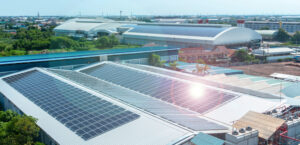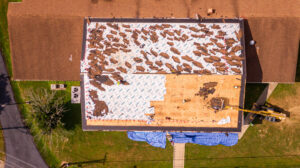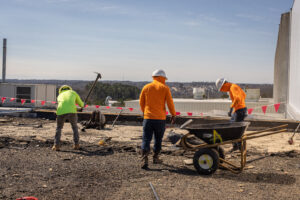It’s that time of year again! As the leaves begin to fall from the trees,
now is the perfect time to start thinking about Fall roof maintenance. After all, your roof is one of the most important components of your commercial building, and it needs to be in top condition to protect your property from the winter weather.
Here at Eskola Roofing, we’ve put together a Fall roof maintenance checklist to help keep your roof in tip-top shape. Let’s get started!
Clean Out the Gutters and Downspouts
Remove leaves, debris, and other debris from your gutters. If you have a large tree or shrub in your yard, clean out branches that may be wedged into the gutter system. After removing all of this material (and checking for clogs), ensure that no other items are blocking the water flow through your downspouts.
Check the Roof Drains
Roof drains are important to check for leaks, debris, and signs of damage or wear. Leaks can be repaired before they become a problem in your building’s structure, but if you don’t find them early enough, they may cause serious structural damage later down the road. To make sure that all of these things are done properly:
- Look at each drain and make sure there aren’t any gaps between it and its surrounding area (or other parts). If there is, then call someone who can fix this issue professionally so as not to waste money fixing something that doesn’t need fixing!
- Check for corrosion around any pipes or fittings that come out from inside buildings onto rooftops where rainwater falls off during heavy rains–this could indicate possible leaks into underground utilities like pipes carrying hot water or sewage lines which would be harmful if exposed over time due to corrosion caused by moisture entering them unscreened by coverings above ground level (the best solution is installing green roofs).
Check the Flashings and Sealants
Sealants are important for keeping the roofing membrane in place and ensuring that no water leaks into the building. If you notice any cracks or openings in your roofing system, fix them immediately before they become bigger problems. It’s always best to catch these things as soon as possible!
You also want to make sure that there aren’t any leaks around where your flashing meets with another piece of metal or plastic—or even just dirt! If there is any kind of leaky part somewhere along this line-up (i.e., between two pieces), then replace it right away using proper roof sealing, which will ensure that no moisture gets into either area while keeping everything secure together without needing extra work afterward, like welding.
Clean Up Leaves, Branches, and Other Debris
The last thing you want to do is have your roof become clogged with leaves or other debris that can be blown onto it during winter. Remove any fallen leaves or branches from your roof, and trim back any trees or shrubs close to the building. This will help reduce the amount of debris that can blow onto your roof during winter storms.
Inspect the Roofing Membrane
Check for blistering, cracking punctures, or other damage. A good way to determine whether your roof is in good shape is to look at it from above. Look for any signs of failure, which could indicate that you need to replace the entire system before anything else happens. You should also inspect any damaged areas on your roofing membrane so that you can get them fixed before they cause further problems down below. If there are any problems with your material, ensure they’re repaired immediately before they cause serious issues later on!
Inspect the roofing system’s expansion joints, seams, and fasteners to check for damage, exposure, or any signs of failure. Expansion joints allow the roofing system to expand and contract with changes in temperature and moisture. If a joint has failed, it will leak water or ice into your attic space where you don’t want it!
Check Roof Curbs, Skylights, and Vents for Leaks or Cracks
Checking the exterior of your building’s skylights, roof vents, and other openings is important because they are all susceptible to water damage in a storm. If you have any issues in these areas, call us today so we can take care of them before they cause more damage than just a little bit of water on your ceiling tiles!
Your roof needs to be maintained regularly to keep it in good condition. If you don’t take care of your roof, it may become damaged and need repairs or replacement.
Following a routine maintenance schedule for your roof will ensure that it lasts many years and protects your investment. A well-maintained roof will also improve the efficiency of your building, saving you money on energy costs.
If you have any questions about roof maintenance or would like to schedule a roof inspection, please get in touch with us today. We would be happy to help you keep your roof in top condition!






